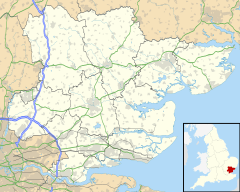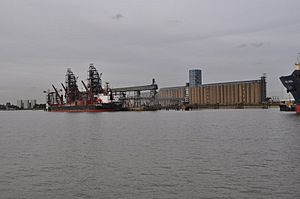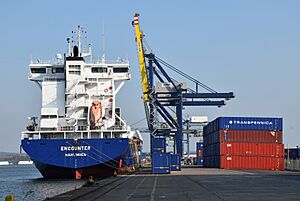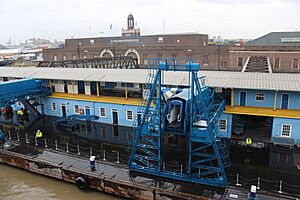Port of Tilbury facts for kids
Quick facts for kids Port of Tilbury |
|
|---|---|
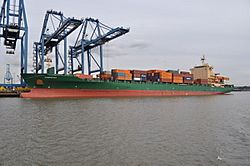 |
|
| Location | |
| Country | UK |
| Location | Tilbury, Essex |
| Coordinates | 51°27′36″N 0°20′42″E / 51.46°N 0.345°E |
| Details | |
| Opened | 1886 |
| Owned by | Forth Ports |
| Available berths | 34 |
| Website https://forthports.co.uk/tilbury-london/ |
|
| Port of Tilbury | |
|---|---|
| OS grid reference | TQ639761 |
| Unitary authority | |
| Ceremonial county | |
| Region | |
| Country | England |
| Sovereign state | United Kingdom |
| Police | Essex |
| Fire | Essex |
| Ambulance | East of England |
| EU Parliament | East of England |
The Port of Tilbury is a busy port on the River Thames in Tilbury, Essex, England. It's a very important port for London, handling lots of different goods. It's also the main port in the United Kingdom for bringing in paper.
The port has huge areas for containers, grain, and other large amounts of cargo. It also has special places for importing cars. The Port of Tilbury is part of the larger Port of London.
Contents
Where is the Port of Tilbury?
The Port of Tilbury is on the north side of the River Thames. It's about 40 kilometers (25 miles) downstream from London Bridge. At this point, the river makes a big loop southwards. The river also gets narrower here, about 730 meters (800 yards) wide.
This area used to be a large marshland. Gravesend, on the other side of the river, was already a place where ships entered. Ships would load and unload their goods and passengers right on the river. There was also a naval dockyard nearby. The new deepwater docks at Tilbury were built to expand all this shipping activity.
The first docks had a special basin that connected to the river. From there, a lock led to a main dock. This main dock had three smaller docks branching off it: East, Central, and West. There were also two dry docks for repairing ships.
How the Port of Tilbury Was Built
Why Tilbury Was Needed
The first docks in London were built close to the city center in the early 1800s. But as railways grew and ships became much bigger, being close to London wasn't as important. It was more important to have access to deep water and plenty of space. It also saved time not having to travel far up the winding Thames River.
Two companies, the East and West India Docks Company (E&WIDC) and the London and St Katherine Dock Company (L&StKDC), were rivals. When the L&StKDC opened the Royal Albert Dock in 1880, it had deepwater access. This dock was about 18 kilometers (11 miles) downstream from London Bridge. The E&WIDC had to build something even better.
Building the Docks
In July 1882, a special law was passed. This law allowed the E&WIDC to build the docks at Tilbury. Building the docks was tricky. The first builders ran into unexpected blue clay and asked for more money. The company removed them from the site in 1884, which led to legal problems.
For a while, the E&WIDC continued building with their own workers. Then, another company called Lucas and Aird was hired to finish the job. The very first ship, the Glenfruin, entered the new docks on April 17, 1886. This ship carried the people for the opening ceremony. The Port of Tilbury opened when steamships were becoming popular. Its location quickly proved to be very useful.
Growing the Docks
In 1909, Tilbury and other docks became part of the new Port of London Authority (PLA). The PLA made big improvements in 1921 and 1929. They built a new lock that was 305 meters (1,000 feet) long and 33.5 meters (110 feet) wide. This lock connected the docks directly to the Thames. They also added a third dry dock for ship repairs.
In the 1960s, while older docks upstream were closing, the PLA made Tilbury even bigger. Between 1963 and 1966, a huge fourth dock was built. It ran almost 1.6 kilometers (1 mile) north from the main dock. The old tidal basin was closed and filled in. In 1969, a new grain terminal opened. It cost £6 million and was built right on the river.
A new container port, costing £30 million, opened in 1967. It took a few years to get everything running smoothly. In 1978, a deepwater berth was opened for very large container ships. This was built on land that was reclaimed from the river.
In 1992, the port became a private company. It joined the Forth Ports group. The PLA still manages the tidal part of the Thames River.
In 2004, the artist Rolf Harris visited the Docks for a TV show. He recreated J. M. W. Turner's famous painting The Fighting Temeraire there.
In 2012, Forth Ports, which owns Tilbury, took full control of Tilbury Container Services Ltd (TCS). They had already owned part of it since 1998.
The Port of Tilbury is also working with Tarmac, a construction materials company. They are building the UK's largest terminal for construction materials. Most of this new project is expected to be ready by the end of 2020.
London Cruise Terminal
One of the shipping companies that used the docks was P&O. In 1916, Tilbury became the only port in London to serve large passenger liners. It opened special berths for P&O ships. As more space was needed, a big new passenger landing stage was built on the Thames. It had train connections and was opened in May 1930.
Tilbury was London's main passenger terminal for ocean liners until the 1960s. For many people, Tilbury was where they started their journey to Australia. This was part of a program where the Australian Government helped people move there. These people, sometimes called 'Ten Pound Poms', boarded ships like RMS Mooltan to start new lives.
Tilbury was also a port where many immigrants arrived. A large group of people from the British West Indies arrived on the ship HMT Empire Windrush in 1948.
The passenger landing stage was reopened in 1995 as the London Cruise Terminal. The old passenger terminal building has been updated over the years. It is now called the "London International Cruise Terminal." The old train station building, which no longer has trains, has been made into a new luggage hall.
Other Activities at the Port
- The Port of Tilbury Police is one of the oldest police forces of its kind in the UK. They are in charge of keeping the port safe and secure.
- The port is also home to the Thurrock Sea Cadets. They use a former minesweeper ship called TS Iveston as their base.
- Apostleship of the Sea is a charity that helps seafarers. They have a chaplain at the port who provides support to sailors.
Tilbury Docks in Movies
The Docks have been used as a filming location for several movies:
- In Brannigan (1975), the Docks were used for John Wayne's character to catch smugglers.
- The Docks pretended to be Venetian waterways in the boat chase scene in Indiana Jones and the Last Crusade (1989).
- A scene from the Jude Law film Alfie (2004) was filmed there.
- Scenes from Batman Begins (2005) were also shot at the Docks.
- In Paddington (2014), the scene where Paddington Bear arrives on a boat was filmed at the Port of Tilbury.


